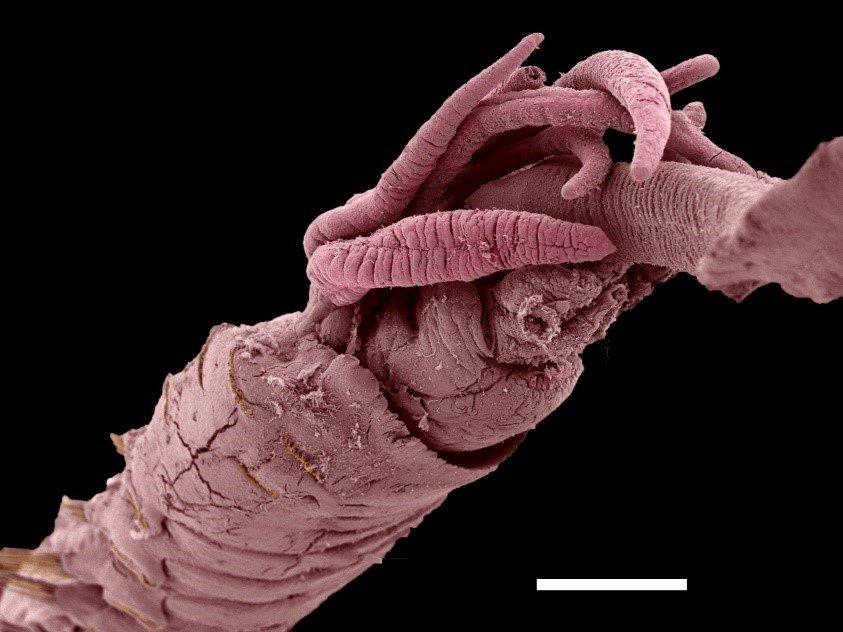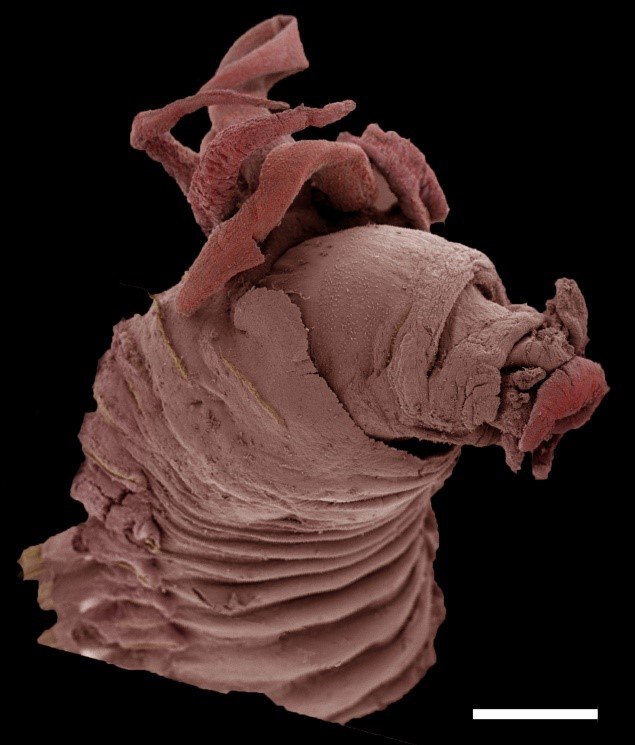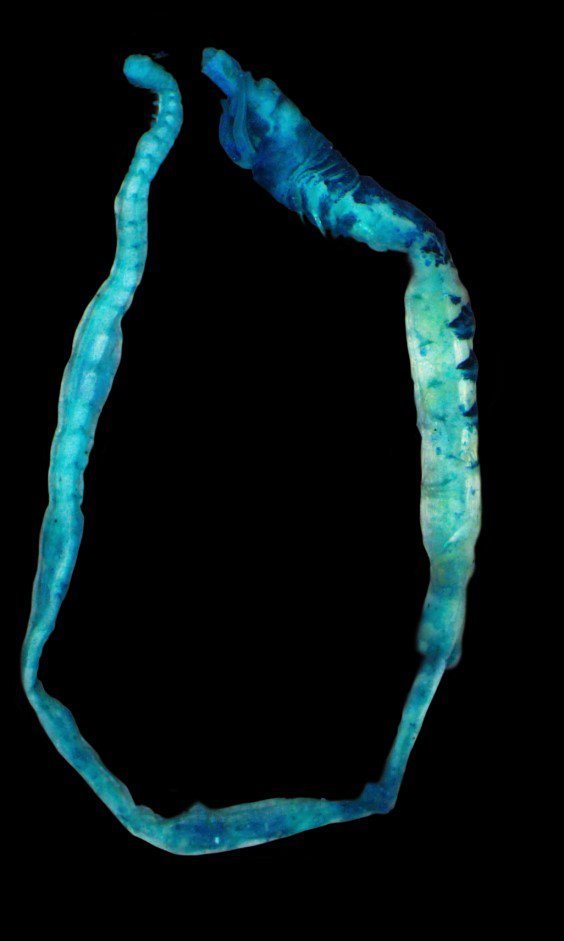Worms under the hammer
Collected thousands of metres below the ocean surface off the coast of Eastern Australia, two new species of deep-sea worm have been discovered. Learn how an unusual auction helped scientists at the Australian Museum and the University Museum of Bergen name these worms…
The deepest parts of our oceans remain unexplored, and thus most species of the deep remain unknown and unnamed. However, names are critical for documenting what lives in deep-water environments and provides baseline species information that allows us to monitor and protect the unique Australian deep-sea environment.

Melinnopsis gardelli anterior end, coloured SEM image. Sue Lindsay at Macquarie University bioimaging lab. Scale bar 1 mm.
Image: Sue Lindsay© Sue Lindsay
In 2017, the Australian research vessel (RV) Investigator expedition ‘Sampling the Abyss’ was the first voyage to systematically collect biological samples from the deep-sea floor (900 – 4,800 metres) along the eastern Australian margin, from Tasmania to Southern Queensland. Over 6,000 worms were collected during the voyage, and these worms were subsequently sent to Sydney and deposited in the Australian Museum Marine Invertebrate collections. Once identified by researchers at the Museum, together with national and international worm colleagues, around 87 % of worm species were thought to be new (i.e. have no scientific name).
Two species from the ‘Sampling the Abyss’ voyage were recently described by researchers at the Australian Museum and University Museum of Bergen, Norway, and named in honour of two individuals who have supported Australian Museum research. The chance to name one of these new deep-sea worm species was auctioned off at the Australian Museum Gala dinner in 2019. The highest bidder was Mr Rickard Gardell, who is a generous patron of the Australian Museum Foundation. The proceeds he donated went towards the genetic analysis and scanning electron microscope imaging used to describe the new species, Melinnopsis gardelli (image below).

Melinnopsis gardelli anterior end, coloured SEM image. Sue Lindsay at Macquarie University bioimaging lab. Scale bar 1 mm.
Image: Sue Lindsay© Sue Lindsay
The second species, Melinnopsis chadwicki (image below) was named after Clarence (‘Clarry’) Chadwick (1909 – 2004). Clarence was an entomologist and a Research Associate at the Australian Museum between 1974 and 1998, where he focused on cycad and insect interaction research. His endowment supports the Chadwick Biodiversity Fellowship at the Australian Museum Research Institute, which Laetitia Gunton (lead author of the study) is a recipient of.

Melinnopsis chadwicki whole specimen stained with methyl blue. Laetitia Gunton AMRI.
Image: Laetitia Gunton© Laetitia Gunton
These two Melinnopsis species live in the sediment on the seafloor. They construct tubes by producing an inner lining of a thin, stiff and clear membrane and then adorning and fortifying this membranous frame with small pieces of sediment. Out of their tubes, they protrude multiple small oral (buccal) tentacles and one very long tentacle (image below). They spread their tentacles out onto the sediment surface to collect tiny food particles and then retract the tentacles back into their mouth bringing in the food.

Melinnopsis gardelli anterior view with long buccal tentacle SEM image. Sue Lindsay at Macquarie University bioimaging lab. Scale bar 1 mm.
Image: Sue Lindsay© Sue Lindsay
Interestingly, this genus of worm (Melinnopsis) has never been recorded before along the east coast of Australia, from either deep or shallow waters. Previously, there was only one record of this genus in Australia from the Great Australian Bight off South Australia. The present research reveals Melinnopsis gardelli is found from Freycinet Marine Park (off Tasmania) to Coral Sea Marine Park (off Queensland) a distance of 2,064 km, with a depth range 2,520–2,821 m. Melinnopsis chadwicki was recorded from Hunter Commonwealth Marine Park (north of Newcastle) to Coral Sea Marine Park, a distance of 996 km and a depth range 1,006–1,257 m.
There are still many more nameless worms in the sea. An estimated 50+ unnamed deep-sea worm species are present in the material collected by the 2017 RV Investigator voyage alone. The work to name them all is ongoing at the Australian Museum, and through collaboration with international colleagues. We are extremely grateful for support from private donors, which has been critical to help us name species and reveal what lives in this previously unknown region of our oceans.
Dr Laetitia Gunton, Chadwick Biodiversity Fellow, Marine Invertebrates, Australian Museum Research Institute
More information:
- Gunton, L., Kupriyanova, E. and Alvestad, T. 2020. Two new deep-water species of Ampharetidae (Annelida: Polychaeta) from the eastern Australian continental margin. Records of the Australian Museum 72(4): 101–121. DOI: 10.3853/j.2201-4349.72.2020.1763.
- Sampling the Abyss voyage information: https://www.csiro.au/about/facilities-collections/mnf/voyages-schedules/voyages/2017/may/in2017_v03
- Gunton, L. 2018. Twelve hundred leagues under the seas. Australian Museum Blog
Support the Australian Museum
Your donation supports the exceptional work of our inspiring scientists, explorers and educators as they help to protect Australia’s vital natural and cultural heritage for generations to come.
Donate now









